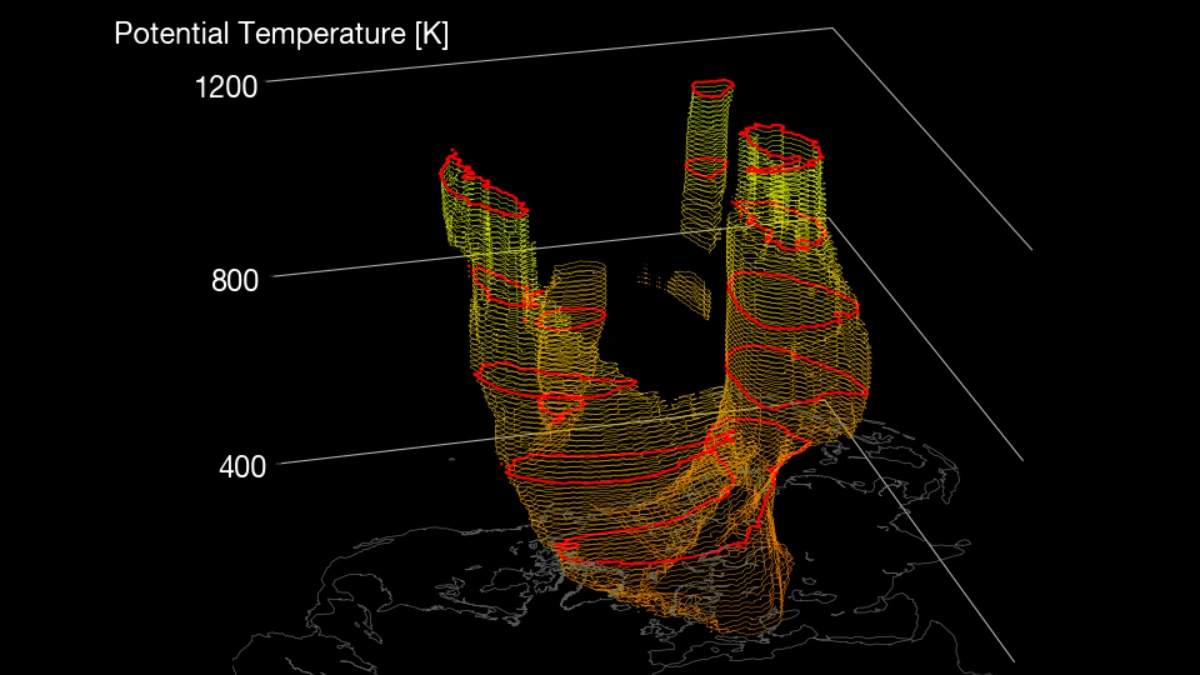Polar vortex collapse to influence spring weather across U.S. and Canada
Large-scale pressure changes following a strong sudden stratospheric warming event in mid-March 2025, which caused the collapse of the polar vortex, are expected to drive spring weather patterns across Canada and the United States into May. Northerly winds are expected to bring colder air into parts of North America, while high-pressure zones may lead to warmer conditions in the central U.S. and southern Canada. The shifts in weather patterns are consistent with the typical effects observed following a polar vortex disruption, where the jet stream becomes more erratic, leading to unusual temperature distributions and weather events.

3D rendition of the polar vortex split - March 20, 2025. Image credit: StratObserve
A strong Sudden Stratospheric Warming (SSW) event in mid-March 2025 triggered a rapid rise in stratospheric temperature and pressure, causing the collapse of the polar vortex. It was one of the strongest SSW events in recent history, causing the Polar Vortex to split into two cores, indicating a strong atmospheric disturbance.
The polar vortex consists of two parts: an upper (stratospheric) layer and a lower (tropospheric) layer. Changes in the upper layer directly influence surface weather patterns in the Northern Hemisphere.
The SSW event disrupts the jet stream, allowing cold air from polar regions to move southward, while high-pressure systems can block typical weather patterns, leading to prolonged anomalies.
The connection between the stratosphere and troposphere is evident in the downward progression of pressure anomalies, impacting surface weather over weeks
The effects of the polar vortex collapse are expected to persist into mid-spring, shaping dynamic weather patterns. Unlike mid-winter, where such events might cause stronger cold outbreaks, spring moderates the intensity of cold air intrusions.
The collapse led to a persistent high-pressure anomaly in the stratosphere, which will descend into the lower atmosphere (troposphere) through April and May. Low-pressure systems are expected to circle around these high-pressure zones, influencing weather patterns through northerly flows of colder air into parts of North America.
A high-pressure zone over the United States and southern Canada is forecast to bring warmer-than-normal temperatures to these regions through late April. However, a low-pressure system over eastern Canada may cause cooler temperatures in the northeastern United States.
Below-normal temperatures are expected in the Midwest and northeastern United States during early May, with a stronger negative temperature anomaly compared to late April due to the lingering effects of the SSW event.
Reference:
1 Polar Vortex collapse effects will impact United States and Canada weather patterns in mid-Spring – SWE – April 18, 2025
Rishav is a skilled researcher specializing in extreme and severe weather reporting. He combines exceptional research capabilities with scientific precision to deliver clear, data-driven articles. Known for uncovering critical information, Rishav ensures his work is accurate, insightful, and impactful. His passion for both science and literature fuels his dedication to producing high-quality news articles. You can reach him at rishav(at)watchers(.)news.



Commenting rules and guidelines
We value the thoughts and opinions of our readers and welcome healthy discussions on our website. In order to maintain a respectful and positive community, we ask that all commenters follow these rules.